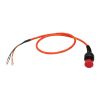NexSens SBP500 Submersible Battery Pack
Features
- Provides power to sensors or data loggers in unattended applications
- Can be used with X-Series data loggers for added battery capacity
- Withstands extreme wave action, drops, floods, and periodic & long-term deployment underwater
- Free ground shipping
- Expedited repair and warranty service
- Lifetime technical support
- More
The SBP500 Submersible Battery Pack accommodates (16) user-replaceable D-cell alkaline batteries in a completely submersible enclosure for power to underwater sensors or data loggers. The housing and battery compartment are completely sealed and waterproof to withstand wave action, drops, floods, periodic & long-term deployment underwater, and more. The SBP500 can also be integrated with X-Series data loggers for added battery capacity.
Internal Power: 36 A-Hr at 20C
Maximum Current Draw: 3 A
Material: PVC body with Acetal battery lid
Weight: 8.5 lbs. without batteries; 13.0 lbs. with batteries
Dimensions: 5.5” (13.97 cm) diameter; 16.0” (40.64 cm) length
Operating Temperature: -20C to 70°C
Rating: Submersible to 200 ft.
- (1) SBP500 Submersible Battery Pack
- (1) 6-pin plug to 8-pin plug cable assembly, 1m
Note: D-cell alkaline batteries sold separately
In The News
Climate Change and Microplastics: Monitoring Lake Champlain
Most people go to Lake Champlain for its exceptional views and thrilling boating, but it’s also home to a wide variety of interesting aquatic research projects. From studying microplastics to thermal dynamics of the lake, Timothy Mihuc, director of the Lake Champlain Research Institute (LCRI) at the State University of New York at Plattsburgh (SUNY Plattsburgh), has spent his career studying aquatic ecosystems. As an aquatic biologist, he’s the main investigator on Lake Champlain’s research studies while also managing their grants, employees, and their hands-on buoy work. Over the years, LCRI has received a number of environmental grants that aid in its monitoring research.
Read MoreCurrent Monitoring after the Francis Scott Key Bridge Collapse
On March 26th, according to The Baltimore Sun , a 984-foot, 112,000-ton Dali lost propulsion and collided with a support column of the Francis Scott Key Bridge, collapsing the structure. Soon after the event, search and rescue, salvage crews, and other emergency responders were mobilized after the collision. As salvage efforts progressed in early April, NOAA’s Center for Operational Oceanographic Products and Services (CO-OPS) responded to a request for real-time tidal currents data and deployed a current monitoring buoy—CURBY (Currents Real-time BuoY)—into the Patapsco River north of the Francis Scott Key Bridge.
Read MoreSoundscapes of the Solar Eclipse: Citizen Science Supporting National Research
On April 8, 2024, millions of people around the world had their eyes glued to the sky to witness a historic cosmic event. The total solar eclipse captured the headlines and the minds of many who became eager to gaze at the heavens as the sky went dark for a few minutes. However, not everyone used their sense of sight during the eclipse, some were listening to the sounds of the natural world around them as the light faded from above. The Eclipse Soundscape Project is a NASA-funded citizen science project that focuses on studying how the annular solar eclipse on October 14, 2023, and the April 8, 2024 total solar eclipse impacted life on Earth. The project revisits an initiative from the 1930s that showed animals and insects are affected by solar eclipses.
Read More

















